 Dalla bella Medellin arrivo in volo nella calda anzi caldissima e umidissima Santa Marta (SM).
Se il buongiorno si vede dal mattino.. sarei dovuta tornare indietro di corsa: il volo e' stato un'esperienza socio-culturale mista di terrore e folklore. Non voglio parlare di turbolenza perché quello che abbiamo sperimentato e' stato un cammino su salite e discese ripide e scale con migliaia di gradini, fatte in aereo. A parte lo stomaco nelle orecchie, la parte migliore dell'esperienza e' stata la reazione degli altri passeggeri: c'erano persone che in continuazione si facevano il segno della croce, altri che pregavano che neanche a San Pietro ci sono cosi tanti devoti; mentre altri hanno dato sfogo alla paura snocciolando un calendario di parolacce e santi. Questi intensi momenti erano intervallati da momenti tranquilli di volo accompagnati da forti risa e chiacchiericcio rumoroso. Un'altalena bulimica di umori che ho faticato a seguire e che fortunatamente e' finita dopo due orette.
Santa Marta
35 gradi umidi di calore travolgente.
Dalla bella Medellin arrivo in volo nella calda anzi caldissima e umidissima Santa Marta (SM).
Se il buongiorno si vede dal mattino.. sarei dovuta tornare indietro di corsa: il volo e' stato un'esperienza socio-culturale mista di terrore e folklore. Non voglio parlare di turbolenza perché quello che abbiamo sperimentato e' stato un cammino su salite e discese ripide e scale con migliaia di gradini, fatte in aereo. A parte lo stomaco nelle orecchie, la parte migliore dell'esperienza e' stata la reazione degli altri passeggeri: c'erano persone che in continuazione si facevano il segno della croce, altri che pregavano che neanche a San Pietro ci sono cosi tanti devoti; mentre altri hanno dato sfogo alla paura snocciolando un calendario di parolacce e santi. Questi intensi momenti erano intervallati da momenti tranquilli di volo accompagnati da forti risa e chiacchiericcio rumoroso. Un'altalena bulimica di umori che ho faticato a seguire e che fortunatamente e' finita dopo due orette.
Santa Marta
35 gradi umidi di calore travolgente.
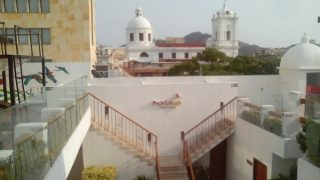 Arrivando di domenica ho ovviamente trovato tutto 'cerrado', ma anche il giorno seguente (un altro lunedì di festa) ho avuto lo stesso panorama: tutti i negozi o quasi tutti erano chiusi per riposo. Fortunella io!
La cittadina si affaccia sul mare (che pero' non e' tanto bello), piccolina con un centro fatto di stradine strette e caratteristiche che si concentrano intorno alla piazza dei fidanzati (Plaza de los novios) e il lungomare. In generale carina ma niente di che, mi ha fatto pensare ai piccoli paesini del sud italiano caratteristici e decadenti, ma con tanti piu gringos. Infatti SM e' punto di partenza o di approdo per tutti i turisti e viaggiatori che si dirigono verso il deserto della Guajira (come la sottoscritta) o chi prosegue verso la coste ovest (verso Cartagena). Insomma tanto caldo, strade deserte, tanti visi pallidi in giro e mare poco pulito erano le premesse della nuova esperienza costiera … almeno l'ostello era bello, pulito e con piscina sul terrazzo – livello de-lux!
Menzione speciale agli incontri in aeroporto: una coppia del posto si offre di condividere il taxi, ma nel frattempo avevo conosciuto altre due ragazze (una tedesca e una messicana) con le quali avevo già deciso di condividere il trasporto... insomma tutti che vogliono condividere tutto.. un gran bel momento umano!
Palomino
Arrivando di domenica ho ovviamente trovato tutto 'cerrado', ma anche il giorno seguente (un altro lunedì di festa) ho avuto lo stesso panorama: tutti i negozi o quasi tutti erano chiusi per riposo. Fortunella io!
La cittadina si affaccia sul mare (che pero' non e' tanto bello), piccolina con un centro fatto di stradine strette e caratteristiche che si concentrano intorno alla piazza dei fidanzati (Plaza de los novios) e il lungomare. In generale carina ma niente di che, mi ha fatto pensare ai piccoli paesini del sud italiano caratteristici e decadenti, ma con tanti piu gringos. Infatti SM e' punto di partenza o di approdo per tutti i turisti e viaggiatori che si dirigono verso il deserto della Guajira (come la sottoscritta) o chi prosegue verso la coste ovest (verso Cartagena). Insomma tanto caldo, strade deserte, tanti visi pallidi in giro e mare poco pulito erano le premesse della nuova esperienza costiera … almeno l'ostello era bello, pulito e con piscina sul terrazzo – livello de-lux!
Menzione speciale agli incontri in aeroporto: una coppia del posto si offre di condividere il taxi, ma nel frattempo avevo conosciuto altre due ragazze (una tedesca e una messicana) con le quali avevo già deciso di condividere il trasporto... insomma tutti che vogliono condividere tutto.. un gran bel momento umano!
Palomino
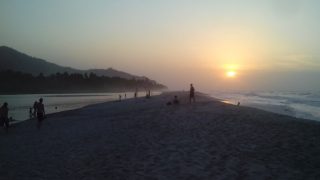 A un'ora e mezza da SM c'e' Palomino, un micro paesino che vive di turismo e pesca (credo). Il Palomino e' un fiume, da cui il paese prende il nome, cristallino e impassibile che si immette in mare offrendo una piacevole alternativa tra acqua dolce e acqua marina, separate da un lembo di spiaggia frequentato da pochi. Palomino si presenta con la tipica spiaggia caraibica con palme e foresta alle spalle sulla terra ferma e mare incredibile davanti. Qui incontro i miei futuri compagni di viaggio: Antonietta – calabrese espatriata a Barcellona, anche lei in sabbatico, e Johannes – tedesco in giro per forse 4 mesi per l'America del Sud. Particolare interessante: io e Johannes siamo stati a Medellin nella stessa settimana e nello stesso ostello, ci siamo incrociati diverse volte ma mai parlati. Inizio a capire che il mondo e' veramente piccolo.
A un'ora e mezza da SM c'e' Palomino, un micro paesino che vive di turismo e pesca (credo). Il Palomino e' un fiume, da cui il paese prende il nome, cristallino e impassibile che si immette in mare offrendo una piacevole alternativa tra acqua dolce e acqua marina, separate da un lembo di spiaggia frequentato da pochi. Palomino si presenta con la tipica spiaggia caraibica con palme e foresta alle spalle sulla terra ferma e mare incredibile davanti. Qui incontro i miei futuri compagni di viaggio: Antonietta – calabrese espatriata a Barcellona, anche lei in sabbatico, e Johannes – tedesco in giro per forse 4 mesi per l'America del Sud. Particolare interessante: io e Johannes siamo stati a Medellin nella stessa settimana e nello stesso ostello, ci siamo incrociati diverse volte ma mai parlati. Inizio a capire che il mondo e' veramente piccolo.
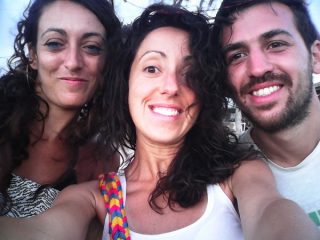 Con loro decidiamo di proseguire per Cabo della Vela, nel cuore della Guajira – zona desertica della Colombia; la sera prima della partenza incontriamo Facundo – giovane e gentile argentino alla scoperta del mondo, che non ci pensa due volte ad accodarsi. Sembriamo una barzelletta, due italiane, un tedesco ed un argentino.
Prima di partire decido con Johannes di lasciarmi tentare dall'attrazione del posto: farsi trascinare dalla corrente con una camera d'aria gigante dalla montagna dove (quasi) nasce il fiume Palomino fino al mare. E' stata un'esperienza divertente e rilassante ma fino ad un certo punto: per scendere si impiega circa 3-4 ore, passate interamente a mollo e sotto al sole. L'ultimo pezzo abbiamo camminato ci eravamo stancati di galleggiare.
Cabo de la Vela
Questa e' la zona nord del deserto della Guajira, dove vive la comunità indigena dei Wayuu: gli indigeni di qui sono semi integrati con il resto del paese, nel senso che lavorano con I turisti e hanno contatti con le persone di Uribia, dove c'è la massima concentrazione di indigeni Wayuu dell'intera Colombia.
Con loro decidiamo di proseguire per Cabo della Vela, nel cuore della Guajira – zona desertica della Colombia; la sera prima della partenza incontriamo Facundo – giovane e gentile argentino alla scoperta del mondo, che non ci pensa due volte ad accodarsi. Sembriamo una barzelletta, due italiane, un tedesco ed un argentino.
Prima di partire decido con Johannes di lasciarmi tentare dall'attrazione del posto: farsi trascinare dalla corrente con una camera d'aria gigante dalla montagna dove (quasi) nasce il fiume Palomino fino al mare. E' stata un'esperienza divertente e rilassante ma fino ad un certo punto: per scendere si impiega circa 3-4 ore, passate interamente a mollo e sotto al sole. L'ultimo pezzo abbiamo camminato ci eravamo stancati di galleggiare.
Cabo de la Vela
Questa e' la zona nord del deserto della Guajira, dove vive la comunità indigena dei Wayuu: gli indigeni di qui sono semi integrati con il resto del paese, nel senso che lavorano con I turisti e hanno contatti con le persone di Uribia, dove c'è la massima concentrazione di indigeni Wayuu dell'intera Colombia.
 Sulla comunità Wayuu si potrebbe parlare per ore: partendo dalle loro origini di lotte etniche per il riconoscimento, dalla struttura matriarcale per arrivare al loro lavoro di artigianato – incredibile cosa riescono a fare tessendo, credo di aver visto le amache piu belle al mondo, per non parlare delle famosissime ed uniche borse Wayuu. Per quello che ho capito la società Wayuu e' divisa in 12 clan, ognuno dei quali ha un nome, simbolo e animale di riferimento. Le donne se la comandano in tutto (pensate che si e' considerati Wayuu solo se nati da mamma indigena), ma gli uomini possono essere poligami. Piccolo elemento contradditorio, che ho scoperto dalle due donne che ci ospitano a Cabo: apparentemente anche se avere piu mogli non e' legale e le donne non lo accettano, gli uomini hanno più nuclei familiari. In pratica sembra che la regione abbia 'uno statuto speciale ed indipendente' muovendosi al limite della legalità.
Arrivare a Cabo de La Vela e' un'esperienza e solamente il viaggio merita: da Palomino con un bus si raggiunge un posto che si chiama 4 strade, da dove se ne prende un altro per Uribia, la capitale della regione della Guajira, e da li trova - o meglio si deve contrattare, un posto in jeep per raggiungere Cabo con un viaggio di 1 ora e mezza nel nulla del deserto colombiano.
Le contrattazioni sugli autobus per i biglietti (eravamo in 4!), la spesa di viveri e acqua per affrontare il deserto e il viaggio - accroccati con altre 10 persone, bimbi inclusi, in jeep con zaini, rifornimenti per i locali e viveri sul tettino, sono stati da sballo(ttamento).
Sulla comunità Wayuu si potrebbe parlare per ore: partendo dalle loro origini di lotte etniche per il riconoscimento, dalla struttura matriarcale per arrivare al loro lavoro di artigianato – incredibile cosa riescono a fare tessendo, credo di aver visto le amache piu belle al mondo, per non parlare delle famosissime ed uniche borse Wayuu. Per quello che ho capito la società Wayuu e' divisa in 12 clan, ognuno dei quali ha un nome, simbolo e animale di riferimento. Le donne se la comandano in tutto (pensate che si e' considerati Wayuu solo se nati da mamma indigena), ma gli uomini possono essere poligami. Piccolo elemento contradditorio, che ho scoperto dalle due donne che ci ospitano a Cabo: apparentemente anche se avere piu mogli non e' legale e le donne non lo accettano, gli uomini hanno più nuclei familiari. In pratica sembra che la regione abbia 'uno statuto speciale ed indipendente' muovendosi al limite della legalità.
Arrivare a Cabo de La Vela e' un'esperienza e solamente il viaggio merita: da Palomino con un bus si raggiunge un posto che si chiama 4 strade, da dove se ne prende un altro per Uribia, la capitale della regione della Guajira, e da li trova - o meglio si deve contrattare, un posto in jeep per raggiungere Cabo con un viaggio di 1 ora e mezza nel nulla del deserto colombiano.
Le contrattazioni sugli autobus per i biglietti (eravamo in 4!), la spesa di viveri e acqua per affrontare il deserto e il viaggio - accroccati con altre 10 persone, bimbi inclusi, in jeep con zaini, rifornimenti per i locali e viveri sul tettino, sono stati da sballo(ttamento).
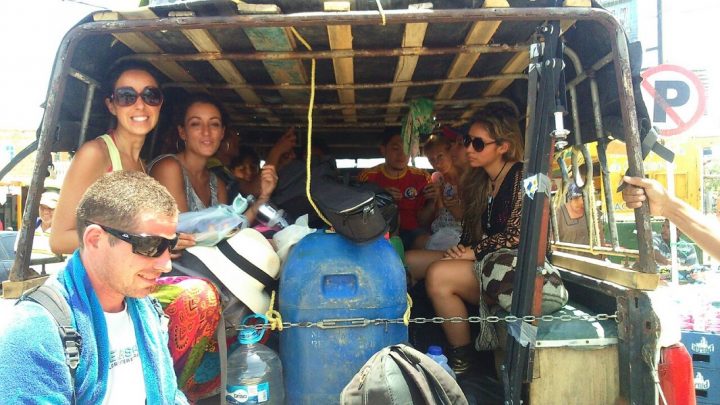 Questa zona e' conosciuta per il contrabbando e i traffici notturni, e non solo notturni, di whisky e benzina, che I colombiani comprano in Venezuela per 12000 pesos e rivendono in Colombia a 60000 pesos. Questo il motivo per il quale bisogna spostarsi accompagnati e sapere dove si sta andando, sarebbe un peccato farsi trovare nel posto sbagliato nel momento sbagliato (me lo hanno ripetuto in molti, e dopo esserci stata, credo che avessero ragione). Ho sentito molte storie del passato, non troppo lontano, di parecchie persone scomparse; molte di cui giovani gringos del nord (America e Europa) - suffragando la mia teoria riguardo i pallidi gringos! Q tontos, pobresitos!
A Cabo non c'è nulla, solo mare, sabbia e vento. Ci sono anche le amache per dormire e due scuole di kite e wind surf. Uno postaccio!
Questa zona e' conosciuta per il contrabbando e i traffici notturni, e non solo notturni, di whisky e benzina, che I colombiani comprano in Venezuela per 12000 pesos e rivendono in Colombia a 60000 pesos. Questo il motivo per il quale bisogna spostarsi accompagnati e sapere dove si sta andando, sarebbe un peccato farsi trovare nel posto sbagliato nel momento sbagliato (me lo hanno ripetuto in molti, e dopo esserci stata, credo che avessero ragione). Ho sentito molte storie del passato, non troppo lontano, di parecchie persone scomparse; molte di cui giovani gringos del nord (America e Europa) - suffragando la mia teoria riguardo i pallidi gringos! Q tontos, pobresitos!
A Cabo non c'è nulla, solo mare, sabbia e vento. Ci sono anche le amache per dormire e due scuole di kite e wind surf. Uno postaccio! Qui, mentre Johannes si faceva un corso di wind suft, con Antonietta e Facundo ho esplorato le spiagge vicine: el Ojo de Agua e el faro rispettivamente a 1 ora e mezza di camminata - strettamente fatta sotto il sole delle 12pm.
Da Cabo si può contrattare il passaggio o tutta l'escursione per Punta Gallina, mio obbiettivo di viaggio sin dall'inizio: dopo Ushuaia, la punta all'estremo sud del mondo latino, non potevo mancare l'estremo nord colombiano.
Qui, mentre Johannes si faceva un corso di wind suft, con Antonietta e Facundo ho esplorato le spiagge vicine: el Ojo de Agua e el faro rispettivamente a 1 ora e mezza di camminata - strettamente fatta sotto il sole delle 12pm.
Da Cabo si può contrattare il passaggio o tutta l'escursione per Punta Gallina, mio obbiettivo di viaggio sin dall'inizio: dopo Ushuaia, la punta all'estremo sud del mondo latino, non potevo mancare l'estremo nord colombiano.
The Caribbean Coast- Colombia The Caribbean Coast of Colombia is incredible, and what is named 'costeño' (from the coast) is like the Italian DOC: the scenery, the food and fruit, not to mention the people and temperatures around there are simply beautiful, tasty and hot. Obviously I liked it so much and clearly I will come back.
 From the beautiful Medellin, I arrived by flight to the hot, but really hot and extremely humid, Santa Marta (SM).
If the day starts from the morning... I should have run back: the flight has been a socio-cultural experience, mixed with terror and folklore. I will not speak about the turbulence because what we experienced was a constant climbing and descending 'up and down' a deep staircase of thousands of steps; this done with an airplane. Apart the feeling of my stomach into the ears, the best part of the experience has been the reaction of other passengers: there were people constantly making the sign of the cross, others praying that not even in St. Peter's Basilica there are so many devotees; while others were so afraid that they were venting - reciting a calendar with all saints and swearing like sailors. These intense moments were paused by quiet moments and accompanied by strong laughs and loud chats. Bulimic swing of moods that I struggled to follow and which fortunately ended after two hour.
Santa Marta
35 degree of humid heat, overwhelming! Arriving on Sunday, I obviously found all 'cerrado' (closed), but also the following day (another holiday on Monday) I had the same situation: all or almost all shops were closed. Lucky me!
From the beautiful Medellin, I arrived by flight to the hot, but really hot and extremely humid, Santa Marta (SM).
If the day starts from the morning... I should have run back: the flight has been a socio-cultural experience, mixed with terror and folklore. I will not speak about the turbulence because what we experienced was a constant climbing and descending 'up and down' a deep staircase of thousands of steps; this done with an airplane. Apart the feeling of my stomach into the ears, the best part of the experience has been the reaction of other passengers: there were people constantly making the sign of the cross, others praying that not even in St. Peter's Basilica there are so many devotees; while others were so afraid that they were venting - reciting a calendar with all saints and swearing like sailors. These intense moments were paused by quiet moments and accompanied by strong laughs and loud chats. Bulimic swing of moods that I struggled to follow and which fortunately ended after two hour.
Santa Marta
35 degree of humid heat, overwhelming! Arriving on Sunday, I obviously found all 'cerrado' (closed), but also the following day (another holiday on Monday) I had the same situation: all or almost all shops were closed. Lucky me!
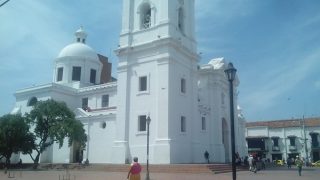 The town is on the water (but this is not so beautiful), petite with a core area made of narrow lanes, which are concentrated around the Square of the fiancés (Plaza de los novios) and the waterfront. Overall it was nice but nothing special, it made me think of the small, characteristic and decadent towns of southern Italy, but with many more gringos. Indeed SM is the arrival and departure place for all tourists and travellers en route to the desert of the Guajira (like myself) or who continues to the west coast (to Cartagena).
Hot temperature, empty streets, many pale faces around and unclean water were the elements of the new coastal experience, not that good isn't it? At least the hostel was nice, clean and with a swimming pool on the terrace - de-lux level!
Special mention for the meetings at the airport: a couple of locals offers to share a taxi, but in the meantime I had met two other girls (one German and one Mexican) with whom I had already decided to share the transport. In short, everybody wanted to share everything.. A great moment of humanity!
Palomino
An hour and a half from SM there is Palomino, a mini town that lives off tourism and fishing (I think). Palomino is also the river, from which the town takes its name, crystalline and impassive that flows in the sea offering a nice alternative between fresh water and sea water, separated by a strip of sandy beach frequented by few.
The town is on the water (but this is not so beautiful), petite with a core area made of narrow lanes, which are concentrated around the Square of the fiancés (Plaza de los novios) and the waterfront. Overall it was nice but nothing special, it made me think of the small, characteristic and decadent towns of southern Italy, but with many more gringos. Indeed SM is the arrival and departure place for all tourists and travellers en route to the desert of the Guajira (like myself) or who continues to the west coast (to Cartagena).
Hot temperature, empty streets, many pale faces around and unclean water were the elements of the new coastal experience, not that good isn't it? At least the hostel was nice, clean and with a swimming pool on the terrace - de-lux level!
Special mention for the meetings at the airport: a couple of locals offers to share a taxi, but in the meantime I had met two other girls (one German and one Mexican) with whom I had already decided to share the transport. In short, everybody wanted to share everything.. A great moment of humanity!
Palomino
An hour and a half from SM there is Palomino, a mini town that lives off tourism and fishing (I think). Palomino is also the river, from which the town takes its name, crystalline and impassive that flows in the sea offering a nice alternative between fresh water and sea water, separated by a strip of sandy beach frequented by few.
 Palomino comes up with the perfect Caribbean beach: palm trees and forest behind on land and incredible ocean front.
Here I met my future traveling companions: Antonietta - Calabrian expatriate in Barcelona, also on sabbatical, and Johannes - German around South America for perhaps few months.
Interesting case: Johannes and I were in Medellin in the same week and in the same hostel, we crossed several times but never spoke. I begin to understand that the world is really small.
With them I decided to go to Cabo de la Vela, in the heart of Guajira - desert area of Colombia. The night before leaving, we met Facundo - young and kind Argentine traveling to discover the world, who did not think twice to tag along. We look like a joke, two Italians, a German and an Argentinean.
Before leaving, with Johannes I decided to try the local attraction: to get floated by the current with a giant tube from the mountain where the Palomino River starts down to the sea. It was fun and relaxing, but up to a certain point: to go down it takes about 3-4 hours, entirely soaking under the sun. On the last piece of the journey we walked, we were tired of staying on the tire floating.
Cabo de la Vela
This is in the North of the Guajira desert, where the indigenous community Wayuu lives: the natives here are semi integrated with the rest of the country, in the sense that they work with tourists and have contacts with people of Uribia, where there is the highest concentration of Wayuu in the whole Colombia.
Palomino comes up with the perfect Caribbean beach: palm trees and forest behind on land and incredible ocean front.
Here I met my future traveling companions: Antonietta - Calabrian expatriate in Barcelona, also on sabbatical, and Johannes - German around South America for perhaps few months.
Interesting case: Johannes and I were in Medellin in the same week and in the same hostel, we crossed several times but never spoke. I begin to understand that the world is really small.
With them I decided to go to Cabo de la Vela, in the heart of Guajira - desert area of Colombia. The night before leaving, we met Facundo - young and kind Argentine traveling to discover the world, who did not think twice to tag along. We look like a joke, two Italians, a German and an Argentinean.
Before leaving, with Johannes I decided to try the local attraction: to get floated by the current with a giant tube from the mountain where the Palomino River starts down to the sea. It was fun and relaxing, but up to a certain point: to go down it takes about 3-4 hours, entirely soaking under the sun. On the last piece of the journey we walked, we were tired of staying on the tire floating.
Cabo de la Vela
This is in the North of the Guajira desert, where the indigenous community Wayuu lives: the natives here are semi integrated with the rest of the country, in the sense that they work with tourists and have contacts with people of Uribia, where there is the highest concentration of Wayuu in the whole Colombia.
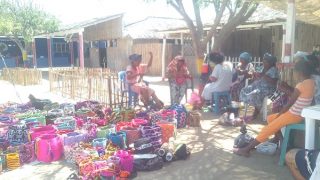 About the Wayuu community I could talk for hours: starting with their origins of ethnic struggles for recognition, from a matrilineal structure to get to their work of craftsmanship - amazing what they can do weaving, I think I saw the most beautiful hammocks in the world, not to mention the famous and unique bags Wayuu.
For what I understood, the Wayuu now is divided into 12 clans, each of which has a name, symbol and reference animal. Women have the command throughout the community (someone is considered Wayuu only is descendent of an indigenous mother), but men are polygamous. Small contradictory element, which I discovered from two women who hosted us in Cabo: although apparently having more wives is not legal and women do not accept it, men have more families. In practice it seems that the region has a special and independent legislation, moving on the edge of legality.
About the Wayuu community I could talk for hours: starting with their origins of ethnic struggles for recognition, from a matrilineal structure to get to their work of craftsmanship - amazing what they can do weaving, I think I saw the most beautiful hammocks in the world, not to mention the famous and unique bags Wayuu.
For what I understood, the Wayuu now is divided into 12 clans, each of which has a name, symbol and reference animal. Women have the command throughout the community (someone is considered Wayuu only is descendent of an indigenous mother), but men are polygamous. Small contradictory element, which I discovered from two women who hosted us in Cabo: although apparently having more wives is not legal and women do not accept it, men have more families. In practice it seems that the region has a special and independent legislation, moving on the edge of legality.
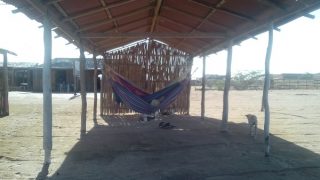 Get to Cabo de La Vela is an experience and only the journey is worth it! From Palomino with a bus you reach a place called 4 roads, where you need to take another one to Uribia, the regional capital of Guajira, and to find - or rather to haggle, a place in a jeep to reach Cabo with a journey of 1 hour and a half into the Colombian desert.
The tickets’ bargain on buses (we were 4!), the food and water shopping to face the desert and the journey - 'stored' with 10 other people, including children, in a jeep with backpacks, supplies for the local food on the roof, have been cool and rock(ing).
This area is well-known for smuggling and trafficking, and not only at night, whiskey and gasoline, that Colombians buy in Venezuela for 12,000 pesos and resell to 60,000 pesos in Colombia. This is the reason why one must move with others and know where he is going, it would be a shame to be found in the wrong place at the wrong time (I heard this from many, and after having been there, I think they were right). I heard many stories of the past, not too far away, of several missing persons; many of which young gringos from North (America and Europe) - giving evidences to my theory about the pale gringo! Q tontos, pobresitos!
Get to Cabo de La Vela is an experience and only the journey is worth it! From Palomino with a bus you reach a place called 4 roads, where you need to take another one to Uribia, the regional capital of Guajira, and to find - or rather to haggle, a place in a jeep to reach Cabo with a journey of 1 hour and a half into the Colombian desert.
The tickets’ bargain on buses (we were 4!), the food and water shopping to face the desert and the journey - 'stored' with 10 other people, including children, in a jeep with backpacks, supplies for the local food on the roof, have been cool and rock(ing).
This area is well-known for smuggling and trafficking, and not only at night, whiskey and gasoline, that Colombians buy in Venezuela for 12,000 pesos and resell to 60,000 pesos in Colombia. This is the reason why one must move with others and know where he is going, it would be a shame to be found in the wrong place at the wrong time (I heard this from many, and after having been there, I think they were right). I heard many stories of the past, not too far away, of several missing persons; many of which young gringos from North (America and Europe) - giving evidences to my theory about the pale gringo! Q tontos, pobresitos!
 In Cabo there is nothing, just sea, sand and wind. There are also hammocks for sleeping and two schools of kite and wind surfing. A really bad place!
Here, while Johannes did a wind surf course, with Antoinetta and Facundo, I explored the nearby beaches: el Ojo de Agua and el faro respectively 1½ hours walking - strictly done under the sun of 12pm.
From Cabo you can bargain passage to travel to Punta Gallina, my goal from the beginning of this journey: after Ushuaia, the most southern tip of the latino world, I could not miss the extreme north of it.
In Cabo there is nothing, just sea, sand and wind. There are also hammocks for sleeping and two schools of kite and wind surfing. A really bad place!
Here, while Johannes did a wind surf course, with Antoinetta and Facundo, I explored the nearby beaches: el Ojo de Agua and el faro respectively 1½ hours walking - strictly done under the sun of 12pm.
From Cabo you can bargain passage to travel to Punta Gallina, my goal from the beginning of this journey: after Ushuaia, the most southern tip of the latino world, I could not miss the extreme north of it. 